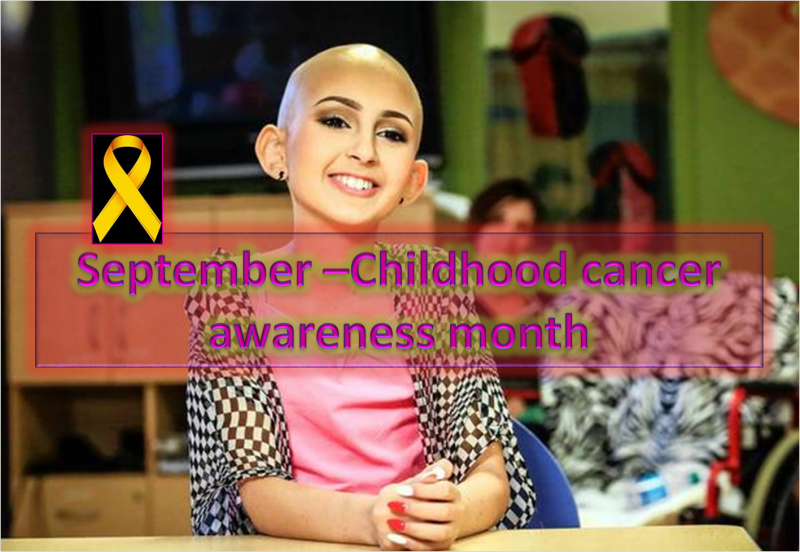
Childhood cancer awareness month-September
September is the childhood – cancer awareness month. Cancer is a disease in which cells grow and divide with little or no control. There are many different types of cancer. Cancers are typically named for the organ or the cell where the cancer begins. Some cancers can spread from the original site and move to other places in the body.
Cancer in children:
The loss of a child to cancer is one of the worst tragedies a family can face. Each death means the loss of an entire lifetime. And survivors face serious medical complications, secondary cancers, cognitive impairments and shortened lifespans. Each year, the parents of approximately 15,700 kids will hear the words “your child has cancer.” Across all ages, ethnic groups and socio-economics, this disease remains the number one cause of death by disease in children. Despite major advances – from an overall survival rate of 10 percent just fifty years ago to nearly 90 percent today, for many rare cancers, the survival rate is much lower. Furthermore, the number of diagnosed cases annually has not declined in nearly 20 years.
The most common types of cancer diagnosed in children and adolescents are leukemia, brain and other central nervous system tumors, lymphoma, rhabdomyosarcoma, neuroblastoma, Wilms tumor, bone cancer, and gonadal (testicular and ovarian) germ cell tumors.
What causes cancer in children?
Cancer in children occurs when formerly-healthy cells mutate, and replicate much more than they should. When that happens, they can also destroy nearby healthy cells and invade different parts of the body. Researchers still do not know much about what causes cancer in children. Most children’s cancers are caused by random genetic mutations that can lead to cancer. For some of these mutations, there are some environmental and genetic factors that can contribute to the cancer growing. But we still do not know what causes most childhood cancers.
Each year, more than 15,500 children are diagnosed with cancer. Today, nearly 90% of these children will survive.
Facts about childhood cancer:
- Every day, 43 children are diagnosed with cancer.
- 12% of children diagnosed with cancer do not survive.
- Children’s cancer affects all ethnic, gender and socio-economic groups.
- More than 40,000 children undergo treatment for cancer each year.
- 60% of children who survive cancer suffer late-effects, such as infertility, heart failure and secondary cancers.
- Problems related to cancer treatment that occur or persist after treatment is completed are known as “late effects.” Unfortunately, three out of five survivors develop late effects. If they do occur, it is best to catch these early so treatment can begin right away. This is why ongoing follow-up care for children’s cancer survivors is so important.
- There are approximately 375,000 adult survivors of children’s cancer in the United States.
- That equates to 1 in 530 adults ages 20-39.
- Cancer kills more children than AIDs, asthma, diabetes, cystic fibrosis and congenital anomalies combined.
- The average age of death for a child with cancer is 8, causing a child to lose 69 years of expected life.
- 74% of childhood cancer survivors have chronic illnesses, and some 40% of childhood cancer survivors have severe illnesses or die from such illnesses.
- Childhood cancer survivors are at significant risk for secondary cancers later in life.
- Cancer treatments can affect a child’s growth, fertility, and endocrine system. Child survivors may be permanently immunologically suppressed.
- Radiation to a child’s brain can significantly damage cognitive function, or if radiation is given at a very young age, limiting the ability to read, do basic math, tell time or even talk.
- Physical and neurocognitive disabilities resulting from treatment may prevent childhood cancer survivors from fully participating in school, social activities and eventually work, which can cause depression and feelings of isolation.
- Childhood cancer survivors have difficulty getting married and obtaining jobs, health and life insurance.
- Although survival rates for most childhood cancers have improved in recent decades, the improvement has been especially dramatic for a few cancers, particularly acute lymphoblastic leukemia, which is the most common childhood cancer.
It is important to keep records of childhood cancer survivor: It is also important to keep a record of the cancer treatment that someone received as a child. This record should include:
- The type and stage of cancer
- Date of diagnosis and dates of any relapses
- Types and dates of imaging tests
- Contact information for the hospitals and doctors who provided treatment
- Names and total doses of all chemotherapy drugs used in treatment
- The parts of the body that were treated with radiation and the total doses of radiation that were given
- Types and dates of all surgeries
- Any other cancer treatments received
- Any serious complications that occurred during treatment and how those complications were treated
- The date that cancer treatment was completed
While coping with a cancer diagnosis and managing the treatments is painful and challenging, it is important to remember that the majority of children’s cancer patients survive this frightening disease. There are many things one can do to provide informational, practical, and emotional support that can make a significant difference for the quality of life for the child with cancer, the caregivers, and other family members. The support of the community can make the family feel cared for, valued, and respected during a time of stress. We live in this society and let us pledge to help a family who is going through tough time.
Reference:
- http://curesearch.org/
- http://www.kidsvcancer.org/
- http://www.alexslemonade.org/
- http://www.cancer.gov/
- https://unite2cure.org/
- Image credit: Talia Castellano Face Book page
Author: Sumana Rao | Posted on: September 22, 2021
« Weight loss Fat Patch is trialled in US Practice Yoga every morning to fight COVID-19 -Harvard scholars »






















Write a comment